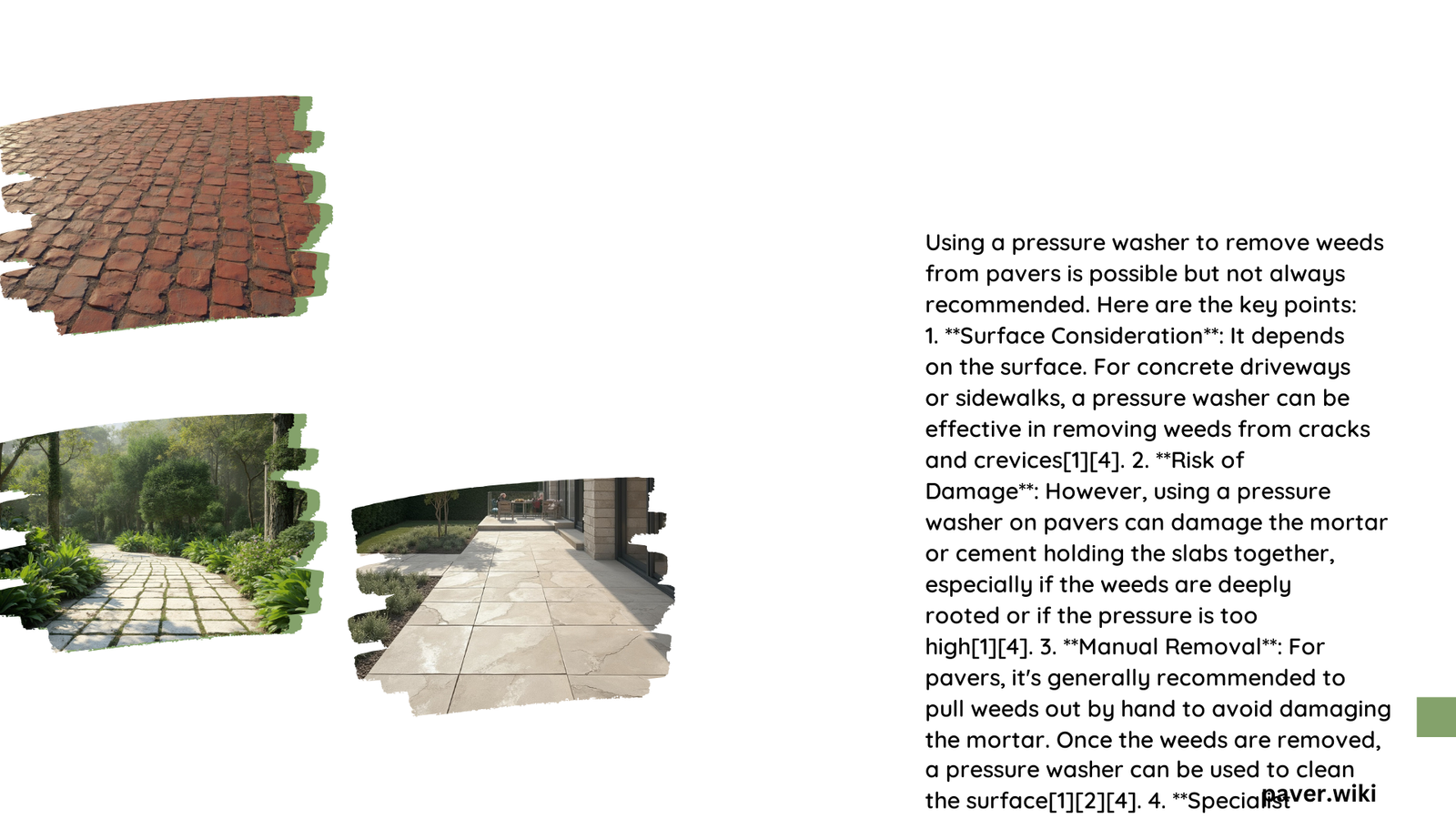Pressure washers are effective tools for removing weeds from pavers. They can blast away unwanted vegetation, dirt, and debris from paver surfaces and joints. While the effectiveness varies depending on factors like weed type and paver condition, pressure washing is generally a quick and efficient method for weed removal. This article explores the use of pressure washers for weed removal from pavers, including optimal settings, best practices, and comparisons to manual methods.
What Makes Pressure Washers Effective for Weed Removal?
Pressure washers are powerful cleaning tools that use high-pressure water streams to remove dirt, grime, and vegetation. When it comes to weed removal from pavers, pressure washers offer several advantages:
- High-pressure water jets: The forceful water stream can dislodge weeds from paver joints and surfaces.
- Versatility: Adjustable pressure settings allow for cleaning various paver types without damage.
- Speed: Pressure washers can clean large areas quickly compared to manual methods.
- Deep cleaning: The high-pressure water can reach deep into paver joints, removing weed roots.
How Effective Are Pressure Washers Against Different Weed Types?

The effectiveness of pressure washers in removing weeds from pavers can vary depending on the type of weed:
- Shallow-rooted weeds: Highly effective, often removing them completely
- Deep-rooted weeds: May require multiple passes or additional treatment
- Moss and algae: Very effective in removing these surface-level growths
- Grass: Can remove most grass growth, but may need follow-up treatment for stubborn patches
While specific effectiveness rates are not available, pressure washers are generally considered highly effective for most weed types commonly found in paver joints.
What Are the Optimal Pressure Washer Settings for Weed Removal?
To effectively remove weeds without damaging pavers, consider the following settings:
- Pressure (PSI):
- Beginners: 1000-1500 PSI
-
Experienced users: Up to 3000 PSI (use with caution)
-
Nozzle types:
- 25° green nozzle
- 40° white nozzle
-
60° black nozzle for wider areas
-
Distance and angle:
- Keep nozzle 12 inches away from the surface
- Maintain a 30° angle to the paver surface
| Setting | Recommendation |
|---|---|
| Pressure | 1000-3000 PSI |
| Nozzle | 25°-60° fan tip |
| Distance | 12 inches |
| Angle | 30° |
How Does Pressure Washing Compare to Manual Weed Removal Methods?
When comparing pressure washing to manual weed removal methods, consider the following factors:
- Time efficiency:
- Pressure washing: Faster, especially for large areas
-
Manual removal: More time-consuming, better for small areas or spot treatment
-
Cost:
- Pressure washing: $0.50-$2 per square foot (equipment rental or professional service)
-
Manual removal: Lower upfront cost, but more labor-intensive
-
Effectiveness:
- Pressure washing: Highly effective for most weed types and paver conditions
-
Manual removal: Less effective for deeply rooted weeds or large areas
-
Long-term results:
- Pressure washing: Can help prevent future weed growth by cleaning out joint sand
- Manual removal: May require more frequent treatments
What Are the Best Practices for Using a Pressure Washer on Pavers?
To ensure effective weed removal and paver protection, follow these best practices:
- Test a small, inconspicuous area first to check for any adverse effects on the pavers.
- Start with lower pressure settings and increase gradually if needed.
- Keep the nozzle moving to avoid concentrating pressure on one spot.
- Clean in a systematic pattern to ensure complete coverage.
- Use appropriate safety gear, including eye protection and closed-toe shoes.
- After pressure washing, allow pavers to dry completely before applying new joint sand or sealant.
Are There Any Risks or Drawbacks to Using Pressure Washers for Weed Removal?
While pressure washers are effective for weed removal, there are some potential risks to consider:
- Paver damage: Excessive pressure or improper technique can chip or etch pavers.
- Joint sand removal: High pressure can dislodge joint sand, requiring replacement after cleaning.
- Water intrusion: Improper use may force water under pavers, potentially causing settling or shifting.
- Incomplete removal: Some deep-rooted weeds may require additional treatment methods.
- Environmental concerns: Runoff water may contain chemicals or debris that could affect nearby plants or water sources.
What Additional Steps Should Be Taken After Pressure Washing?
To maintain weed-free pavers after pressure washing:
- Allow pavers to dry completely.
- Refill joints with polymeric sand to prevent future weed growth.
- Apply a paver sealer to protect against stains and weed intrusion.
- Implement regular maintenance, including sweeping and spot-cleaning.
- Consider using pre-emergent herbicides for long-term weed prevention.
In conclusion, pressure washers are highly effective tools for removing weeds from pavers. With proper technique and settings, they offer a quick and efficient solution for maintaining clean, weed-free paver surfaces. While there are some risks to consider, the benefits of pressure washing often outweigh manual removal methods, especially for larger areas or stubborn weed growth.
References:
1. https://sunsetpressurewash.com/how-to-do-paver-cleaning-right-restore-a-look-that-wows/
2. https://www.kaercher.com/us/home-garden/know-how/cleaning-pavers.html
3. https://unilock.com/tackling-the-problem-of-weeds-between-pavers/
